Having spent six months living and working in the China Space Station, setting a new record for China’s manned space program with four spacewalks by a single crew, the three Shenzhou-15 taikonauts, known as the “dream crew,” safely returned to the Dongfeng landing site in the Gobi Desert, North China’s Inner Mongolia Autonomous Region and then arrived at Beijing on Sunday.
At around 6:37 am Sunday, the return capsule of the Shenzhou-15 manned spacecraft carrying mission commander Fei Junlong and his fellow crewmembers Deng Qingming and Zhang Lu, conducted a successful touchdown at the Dongfeng landing site. Medical personnel confirmed that the three were in good health, marking a complete success of the return mission, the Global Times has learned from the China Manned Space Agency (CMSA) on Sunday.
The Shenzhou-15 manned spaceship separated from the country’s space station combination at 9:29 pm Saturday (Beijing Time). Before their departure, the Shenzhou-15 crew has handed over the key to the China Space Station to the Shenzhou-16 crew in orbit on Friday.
The three taikonauts on the Shenzhou-16 space station are scheduled to return to the Dongfeng landing site in November. Before their return, the Shenzhou-17 manned spacecraft will visit the docking, according to the CMSA.
Despite being the oldest crew in terms of the average age at 53, the trio delivered multiple firsts and set several records in the country’s manned space history during their 187-day-stay in orbit.
They were given the endearing nickname of “dream crew” by Chinese netizens based on their decades-long preparation for the spaceflight missions. Zhang waited 12 years, Fei 17 years and Deng 24 years.
Deng spent 24 years training and preparing before his first space trip and was also acting as the back-up taikonaut for four earlier Shenzhou missions. Deng was the only member of China’s first batch of astronauts who had not visited space yet still in active service before the Shenzhou-15 mission.
On April 15, the Shenzhou-15 crew executed their fourth extravehicular activity, known as a spacewalking mission, which set a new record with most space walking missions executed by a single crew.
Moreover, the Shenzhou-15 trio has achieved multiple payload tasks outside the space station cabin, human factors engineering technology research, 28 aerospace medical experiments, and 38 space experiments covering life ecology, material science and fluid mechanics among others, through which they have obtained valuable experimental data.
In fact, the Shenzhou-15 crew has already opened a new chapter for the China Space Station with their arrival at the space station on November 30, 2022, as it not only marked the beginning of the first direct hand-over between two manned spaceflight crews but also that the China Space Station would henceforth be permanently inhabited for at least a decade, mission insiders confirmed when speaking with the Global Times.
Following the successful launch and docking of the Tianzhou-6 spacecraft, the Shenzhou-15 taikonauts have also assisted the scientific team in carrying out six to 15 days of cell culture experiments while in orbit. Among them is the first international research on human pluripotent stem cells in vitro hematopoietic differentiation of human embryonic stem cells in space conditions.
Furthermore, the Shenzhou-15 mission is the last step in the construction phase of the China Space Station and with the arrival of the Shenzhou-15 spaceship, the space station has expanded to its largest configuration of three modules and three spaceships, with a total mass of nearly 100 tons.
It was during the Shenzhou-15 mission that the China Space Station became operational as of the end of 2022 and entered a new application and development phase.
The outgoing Shenzhou-15 on May 30 welcomed the Shenzhou-16 crew led by mission commander and veteran taikonaut Jing Haipeng.
After spending around four days together, the Shenzhou-15 crew handed over the key to the China Space Station to the Shenzhou-16 taikonauts on Friday.
It will take around six months for those who serve on long-term spaceflight missions to see a return to their normal physical condition, before they resume training and participate in another round of space flight candidate selection, the Global Times learned from the CMSA.
It will take about one to one and a half years for these candidates to be able to execute another space mission, the CMSA added.
The return of the Shenzhou-15 manned spacecraft is the first mission after the China Space Station was transferred to the application and development stage. To ensure the safe return of the three taikonauts, all systems were carefully deployed and prepared to ensure that the return mission was a complete success, experts noted.
Peng Huakang, the person-in-charge of the manned spacecraft recovery team with the spacecraft developer China Academy of Spacecraft Technology, told the Global Times on Saturday that with the successful return mission as a sign, China’s space rendezvous and docking guidance, navigation and control system, characterized by autonomous fast rendezvous and docking and autonomous adaptive predictive re-entry and return guidance, has been comprehensively upgraded since Shenzhou-12 spacecraft.
In addition, the stable tracking of manned spacecraft through the black barrier area indicates that China has made great breakthroughs in the problem of tracking and measuring manned spacecraft back through the black barrier area.
In the process of the crew returning to Earth, when the spacecraft re-entry capsule enters into the atmosphere, it will get into a black barrier area. At this point, due to high-temperature friction, the entire surface of the capsule will form a plasma, which will lose contact with the ground for a while. This is one of the most dangerous parts of the return journey.
“Our team is responsible for tracking the return mission. The time for the re-entry capsule to enter the black barrier is about 80 seconds. During this time, the re-entry capsule of the spacecraft cannot communicate with ground control. We only have 90 seconds to find and capture the target, which is quite difficult,” Hu Kai, head of Hotian tracking and control team of the Xi’an Satellite Control Center, told the Global Times on Saturday. Hu said that in order to ensure the successful completion of the measurement and control mission, researchers have updated the software and hardware, adopted a dual-device solution, and tested the latest generation of measurement and control equipment for the first time.
(Global Times)




